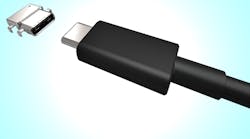This file type includes high-resolution graphics and schematics when applicable.
The USB 3.1 Type-C connector is having a major impact on system design because of its flexibility (see “USB 3.1 Type C Connector Is Reversible”). Its high-speed interface support brings along design challenges as well as features and high throughput, though.
I talked with Gervais Fong, Senior Product Manager for Mixed-Signal PHY IP at Synopsys, to find out about these challenges and how Synopsys is helping designers solve these issues.
Wong: What are the advantages of USB Type-C for device manufacturers?
Fong: USB Type-C is a single-connector standard that can provide data, power, and video. Manufacturers adopting it provide a differentiating feature that makes their product more attractive to buyers. Specifically, the reversibility of the connector and cable orientation makes it easy for the user to understand and appreciate one of the key Type-C features.
Wong: As the largest supplier of IP connectivity solutions, Synopsys is well-positioned to speak to adoption and design trends—what are you seeing that’s different or notable with USB Type-C?
Fong: USB Type-C’s adoption is the fastest in history among USB standards. Many manufacturers in the laptop, Chromebook, smartphone, and tablet markets are already implementing Type-C connectivity in their product feature sets.
In the first phase, they are using discrete components to implement Type-C functionality. While this technique gets the Type-C connector in their products, it doesn’t allow for all of the potential features—10G speeds, power delivery, alternate modes—in the most cost-effective manner possible. Therefore, designers will soon work to reduce their bill-of-materials costs by integrating the Type-C functionality into their ASICs, minimizing their discrete component costs and enabling a fuller, more “future-proof” implementation.
Wong: What are the biggest challenges surrounding USB Type-C for designers?
Fong: The biggest USB Type-C challenges for designers are determining how much USB Type-C functionality they want to implement in their system, and balancing against their designs’ complexity, schedule, and cost pressures. As designers include additional capabilities, it increases the system complexity.
For example, supporting cable and connector reversibility is more complex with 10G USB 3.1 and 5G USB 3.0 compared to USB 2.0. Adding support for the optional USB power-delivery standard, which provides up to 100 W of power, requires implementation of specific power-management features. Supporting the alternate video modes such as DisplayPort requires the implementation and verification of not one, but two different protocols.
Wong: What is Synopsys announcing to address these challenges?
Fong: Synopsys introduced a complete set of design IP and products that help designers implement USB Type-C. First, we introduced optimized USB Type-C PHYs that support the USB 2.0, 3.0, and 3.1 protocols. These optimized PHYs reduce the bill-of-materials cost by eliminating some of the discrete components used to implement USB Type-C. In addition, these optimized PHYs are designed for a small area to minimize silicon costs. Complementing the PHYs, we offer USB Host, Device, and Dual Role Device controllers that support the Type-C standard. To verify the USB Type-C implementation, we provide USB Verification IP. And from a system perspective, we offer FPGA-based IP Prototyping Kits and software-development kits that enable faster system bring-up and driver/software development.
Wong: When it comes to protocol layers for USB Type-C, what types of design strategies are your customers adopting?
Fong: Given the complexity of USB Type-C and its still-evolving implementation options, customers are implementing the USB Type-C-specific configuration channel (CC) logic, and its (optional) Power Delivery PHY and controller, separate from the traditional USB PHY and controller.
In the short term, their current approach is using discrete components that give them the flexibility to modify the system as their needs evolve. This partitioning allows them to add the new Type-C functionality without having to seriously modify the traditional USB controller, PHY, and software stack architecture. Once their products’ USB Type-C feature requirements have matured, they may consider future integration of CC and PD into their PMIC or other chip(s) that can handle the precision analog circuitry and be tolerant to the required voltages and currents.
Further reading:
Synopsys Announces Industry’s First USB Type-C IP Solutions
Converting Existing USB Designs to Support USB Type-C Connections


